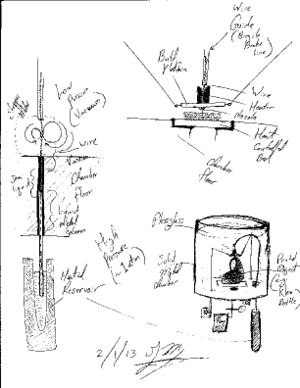Fusionreprap
The FusionReprap
The proposed Fusion Reprap uses common metals to fabricate various objects. The printer relies on fusion welds (also called forge welds) to deposit layers of metal atop one another. To facilitate this welding process, the printed object is fabricated inside a vacuum.
The vacuum is achievable with an amateur set-up. A high vacuum is not necessary for this process. Currently, the theory is that good parts should be able to be produced in a chamber at equal to or less than 30 Torr. The necessity is for nitrogen, water, and oxygen to be sufficiently rare in the environment of the chamber. Removing oxidation from the metal is also necessary for high quality welding. Melting the metal prior to welding would remove (or at least mobilize) oxidation.
Materials
Aluminum is the test metal. Other materials could become feasible in time.
Construction
The set-up is consists of:
- An amateur-quality vacuum chamber (complete with pump, gauge, and tubing).
- A Rostock robot
- A heater for the extruder capable of melting aluminum.
- A wire feed system for the extruder.
- Typical reprap electronics and software (like the Sanguinololu).
- Modifications of various materials and designs of existing systems (like the Rostock and an extruder) to handle high temperature, low pressure, and fit in a small area.
The Bubbler
Currently, a bubbler is under consideration for providing metal to the wire feed system. The bubbler system works as by continuously casting aluminum from an outside reservoir of liquid aluminum. The outside reservoir heats aluminum to a liquid state. A narrow tube (viz. a ceramic straw) is lowered into the reservoir, so that the tip is beneath the level of the liquid. The tube is open to the vacuum within the chamber. Liquid metal is pushed into the tube by atmospheric pressure, similar to a barometer. As the liquid ascends the tube, it cools and solidifies. The cooled aluminum forms a plug, preventing more liquid from rising. This plug occurs where atmospheric pressure and the weight of the liquid are close to equilibrium. (Finding this point is a matter of fine calculation and experimentation.) A motor mechanically pulls the solid aluminum from the column. The pulled metal is pushed into a wire guide (such as a bicycle brake cable). The wire is then received on the other end of the wire guide, melted, and extruded. By keeping the tube narrow, large demands on cooling can be avoided. Simply put, we're only concerned with a small amount of aluminum. A passive system could provide all the cooling necessary for creating thin, solid aluminum wire from a molten pool.
The advantage of the bubbler system is providing--ideally--all the aluminum necessary for a print without restocking the interior of the vacuum chamber. However, stocking the interior with a spool of wire should be very simple.
Developers
- SJ Moquin -- [email protected]
- Julia Longtin -- [email protected]
